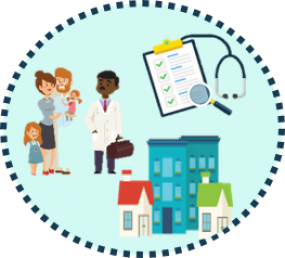REACH Program Impact
REACH is CDC’s Racial and Ethnic Approaches to Community Health program. Since 1999 it has demonstrated that locally-based, culturally-tailored solutions can be effective. Such solutions can reverse the seemingly intractable health gaps in diverse US communities in urban, rural, and tribal areas.
2014-2018
Impact across REACH communities

Over 2.9 million people have better access to healthy foods and beverages

Over 322,000 people benefited from smoke-free and tobacco-free interventions

Approximately 1.4 million people have more opportunities to be physically active

Over 830,000 people have access to local chronic disease programs that are linked to clinics
Community successes
- Partners in DeKalb County, Georgia, increased access to healthy foods for approximately 242,000 African Americans. Partners sold more than 1,000 units of fruits and vegetables each week and reported a 34% increase in consumption of fruits and vegetables among customers.
- Creighton University REACH partnered with the Omaha (Nebraska) Housing Authority to create safer places for physical activity for more than 330 residents of three low-income housing towers.
- In Orange County, California, the REACH program increased access to smoke-free environments for more than 100,000 Asian American residents. The work increased the number of commercial shopping plazas with voluntary smoke-free policies.
- Partners in Cuyahoga County, Ohio, developed the Produce Prescription Program for Hypertension to connect residents in need to healthy eating information and resources. More than 600 low-income patients with high blood pressure gained better access to nutrition education and affordable produce.
- The Toiyabe Indian Health Project increased healthy food production in community gardens. As a result, more than 3,000 American Indians in seven tribes and two tribal communities have more access to healthy foods.
- In Los Angeles, California, the Community Health Council collaborated with the African Americans Building a Legacy of Health program. Together they increased access to healthy and affordable food and beverages through efforts to change institutional practices and promote local investment. These efforts helped leverage support from California’s $200 million Fresh Food Financing Fund which seeks to eliminate food deserts and fight childhood obesity.
2009-2012
Impact across REACH communities
- Decreases in smoking:
- Smoking prevalence decreased 7.5% (or an average of 2.5% per year) among non-Hispanic Blacks and 4.5% among Hispanics.
- Smoking prevalence for Asian men in four REACH communities in California, Washington, and Massachusetts declined significantly. These decreases, ranging from 2.6% to 5.7%, were greater in REACH communities compared to the national decline.
- Reductions in obesity: The prevalence of obesity decreased in REACH US communities, but not in comparison populations, producing a net effect of 1 percentage point per year for 14 disadvantaged black communities.
- Increased fruit and vegetable consumption: In REACH communities that focused on heart disease or diabetes, the percentage of adults who reported eating 5 or more fruits and vegetables daily increased 3.9% among non-Hispanic blacks and 9.3% among Hispanics.
- Improved healthy behaviors: The prevalence of taking hypertensive medication, changing eating habits, cutting down on salt, and reducing alcohol use significantly increased among Hispanics with self-reported hypertension in six REACH communities.
- Increased cholesterol screening: From 2009 to 2011, cholesterol screening increased among African Americans 74% to 78%, Hispanics 58% to 71%, and Asians 53% to 72% in REACH communities, while screening decreased or remained constant among the same population groups nationwide.
Community successes
- In Boston, Massachusetts, 79% fewer children with asthma, many from Hispanic and African American communities, were hospitalized after participating in a 12-month case management program led by Boston Children’s Hospital Community Asthma Initiative. Among the children, 56% had fewer asthma-related emergency department visits and 42% had fewer missed school days.
- The Greater Lawrence Family Health Center is in the Merrimack Valley of Massachusetts. It engaged Latino communities across New England through community-based systems of care and education to eliminate health disparities related to cardiovascular disease and other chronic diseases and conditions. These efforts improved cholesterol levels for Latino patients such that 71.9% of those with diabetes were able to bring their total cholesterol under 200mg/dL.
- The South Eastern African American Center of Excellence in the Elimination of Disparities in Diabetes program is at the Medical University of South Carolina College of Nursing. It implemented healthcare education delivery system improvements for African Americans with diabetes, specifically by increasing knowledge and awareness around diabetes self-management and prevention in South Carolina’s Charleston and Georgetown counties. These efforts resulted in a 44% reduction in amputations for African Americans.
2001-2009
Impact across REACH communities
- From 2001 to 2009, the percentage of Hispanics who reported having hypertension and were taking medication for it increased from less than half to more than two-thirds.
- During the same period, pneumonia vaccination rates increased from 50.5% to 60.5% in Black communities, from 46.0% to 58.5% in Hispanic communities, from 37.5% to 59.7% in Alaskan/Pacific Islander communities, and from 67.3% to 78.7% in Native American communities.
Videos
- REACH: Improving Lives, Inspiring Hope
Hear how local communities take action to improve the health of their residents and reduce racial and ethnic health disparities. Addressing several chronic health conditions including diabetes, cardiovascular health, asthma, cancer, and obesity, innovative programs meet local health needs and demonstrate positive impact. - Community Diabetes Education — Medical University of South Carolina
- Heart Healthy — Choctaw Nation of Oklahoma
- Promotion of Skim Milk in Public Schools — The Institute for Urban Family Health, New York
- Cancer Screening — Orange County Asian and Pacific Islander Community Alliance, Inc., California
- Community Diabetes Education Program — Greater Lawrence Family Health Center, Massachusetts
- Community Health Advisors and Mammography — University of Alabama at Birmingham
- Community Asthma Initiative — Boston Children’s Hospital, Massachusetts
- Diabetes Prevention and Management — Society for Public Health Education, Washington, DC
- Hepatitis B Education — New York University School of Medicine, New York
- Workplace Physical Activity — UCLA Kaiser Permanente Center for Health Equity, California
- Prevention and Control Type 2 Diabetes — Schenectady County Public Health Service, New York
Connect with Nutrition, Physical Activity, and Obesity
